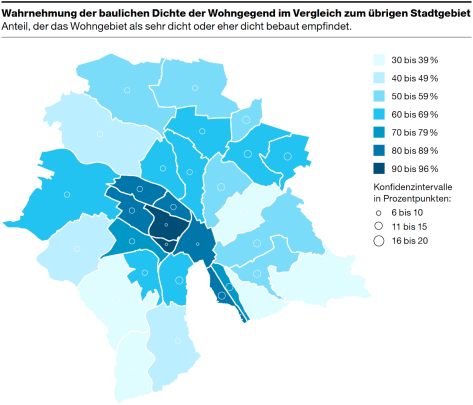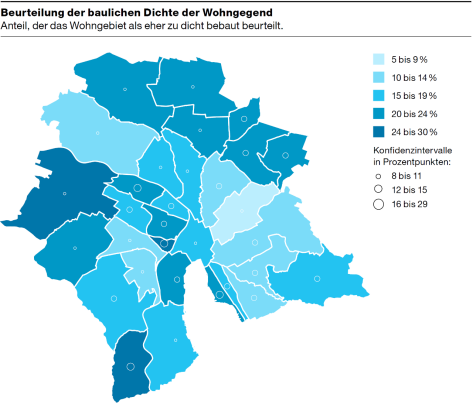How does the population of Zurich see the density of their living environment? An in-depth evaluation of the population survey 2021
19 December 2022 – Larissa Plüss
The City of Zurich pursues the goal of high-quality inner development, which is implemented as socially and environmentally friendly as possible. How dense do the inhabitants perceive their own living environment, and on what factors does this assessment depend? Is there a connection between the perceived and the structural density, or does the perception of the population have to be explained differently? The City of Zurich Population Survey 2021 provides insights into the perception and evaluation of density by the population. [1] By means of a further analysis, different explanations for the different perceptions and assessments of the inhabitants are now being examined.
The city of Zurich is a highly sought-after residential location – since the end of the 1990s, there has been strong, sustained population growth. This growth is in line with the spatial planning requirements of the Confederation and the canton, according to which increased settlement development should take place inwards, mainly in urban areas. With the municipal structure plan and various downstream measures, the City of Zurich is working towards the highest possible quality spatial development. These include the designation of areas that are suitable for additional densification, areas for a good supply of public open spaces, coordination with transport and the supply of renewable energy as well as the general promotion of environmentally and socially compatible urban development. [2]
Perception and evaluation of building density
The population survey (BVB) from 2021 shows that around 80 percent of residents believe that the city of Zurich is developing in a good direction. Around 64 percent of the population think that the city has become more beautiful and liveable due to the construction activity of recent years, and there is a high support of 85 percent for the creation of more housing. At the same time, however, 74 percent of residents regret that more and more free space is being lost due to construction activity (see Fig. 1).
When asked about the density of their own living environment compared to the rest of the city, almost 60 percent of the inhabitants state that their living environment is very or rather densely built-up. A good 40 percent of the population, on the other hand, consider their residential environment to be comparatively loosely built-up (see Fig. 2).
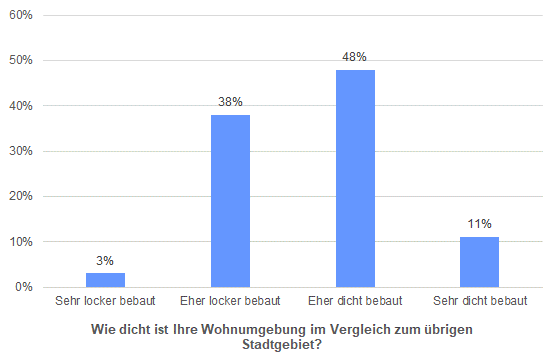
Broken down by quarter, it can be seen that the residential area in districts 1, 4 and 5 as well as in the Seefeld district is most often considered to be very or rather densely built-up. The residential area is least likely to be perceived as dense in the districts of Fluntern, Friesenberg, Leimbach, Weinegg and Witikon (see Fig. 3).
In addition to the perception of the density of one's own living environment, the urban population survey also asked for an evaluation of this density. As shown in Figure 4, a clear majority of 76 percent of residents consider the building density of their residential area to be just right. Almost 20 percent of those surveyed find their own residential area rather too densely built-up.
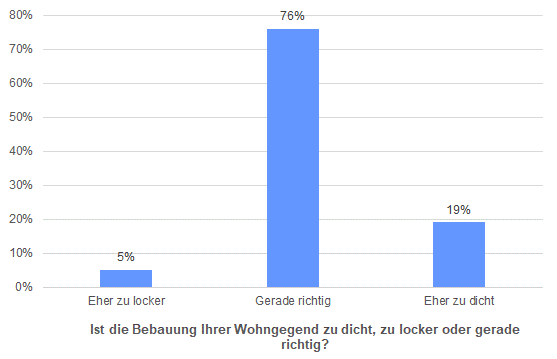
The evaluation by quarter shows that the quarters Altstetten, Leimbach and Werd are most frequently judged to be rather densely built-up (see Fig. 5). Here, up to 30 percent of the population state that the structural density is rather too high. The districts 11 and 12 as well as the districts of Albisrieden, Enge, Escher Wyss, Langstrasse and Seefeld also have a share in the range of 20 to 24 percent of critical voices. These are often districts that have undergone a comparatively strong structural change and/or a strong change in their population composition in recent years. [3]
Revealing findings also emerge from the joint consideration of the two questions: The diagram in Figure 6 contrasts the question of the perception of structural density with the question of the evaluation of this density. It turns out that those people who perceive their living environment as rather or very loosely built-up consider this building density to be just right. In the case of people who, in their opinion, tend to live closely, there are still just under three-quarters who find this density just right. On the other hand, slightly more than half of the respondents who, according to their self-assessment, are at home in a very dense environment, rate this development as rather too dense. The evaluation of the structural density therefore depends clearly on the perceived density of one's own living environment.
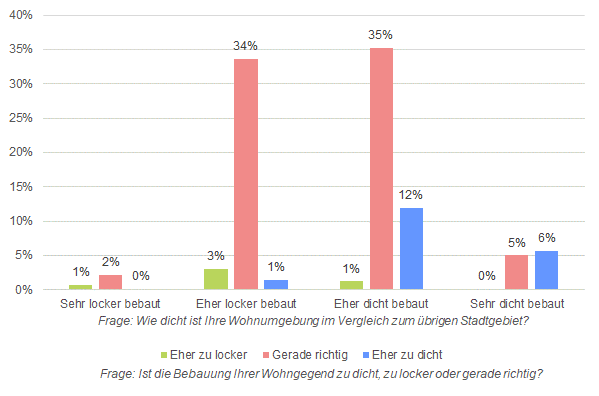
Explanatory factors for the perception and evaluation of density
But to what extent are the perception and evaluation of density determined by the effective structural density of the living environment? Is there a clear connection or are other factors decisive? For example, do age, income level or household composition – and thus different choices regarding the place of residence – play an important role? Or does personal attitude and values on the subject of internal development have a significant influence?
These questions were checked with additional statistical evaluations. Using two logistic regression models, the explanatory power of various indicators could be assessed on the one hand on the perception and on the other hand on the evaluation of density. The indicators are divided into three areas: (1) different spatial indicators (such as building volume, development rate of the parcel or population density in the small quarter), (2) indicators related to individual and household (such as education or home ownership) and (3) indicators related to values (such as attitudes towards densification and growth). All indicators that had a significant influence on the perception or evaluation of density in the bivariate analysis were included in the corresponding regression model. The detailed results of the two models can be found in the methodological appendix.
The statistical evaluations show clear differences between the two regression models: The perception of density on the one hand and the evaluation of this density on the other hand cannot be explained by the same factors. In the first regression model for the perception of density, the strong influence of the actual density of the living environment is mainly visible – the indicators of individual and household, on the other hand, have only a very small effect. The population therefore considers its own living environment to be dense, especially if the building density and the population and employment density are actually high. There is no statistically demonstrable correlation with household budget, educational attainment or household composition. On the other hand, personal attitudes towards construction activity, and in particular fears of a possible loss of free space, also have a significant influence on the regression model. People who regret that more free space could be lost due to construction activity tend to rate their surroundings as denser than the other respondents.
In the second regression model to evaluate density, the effective structural density has a slightly smaller influence than in the first regression model. For example, residents who classify their residential area as rather too dense also live more often in more inhabited areas. However, indicators such as educational attainment and gender also show a significant effect on the assessment of density. Women tend to rate their environment as too dense, and a higher level of education goes hand in hand with a more positive perception of density. As it turns out, however, in this second regression model the general personal attitude towards construction activity and interior development has an even stronger influence than in the first model. For example, the view that one's own residential area is rather too dense is significantly more frequently represented by people who are more critical of the creation of more living space, who more regret a possible loss of open space due to construction activity and who are less likely to agree with the statement that the city has become more beautiful and liveable due to the construction activity of recent years. Personal values therefore have a clear influence on how the density in one's own living environment is assessed and evaluated – and this is largely independent of the actual structural density in the living environment of the respondents.
Summary
The population of the city of Zurich shows a large majority of approval of the urban objective of high-quality inner development and the creation of new living space. In addition, three-quarters of the inhabitants consider the structural density of their living environment to be just right. This clear acceptance of inner development and density is consistent with findings of current research, according to which an urban society that is already familiar with a high building density is most open to further densification. [4],[5],[6] However, almost 20 percent of Zurich's urban population classify their residential environment as rather too dense – this is often the case in those districts that have undergone a comparatively strong structural change and/or a strong change in their population composition in recent years.
The statistical analyses have also shown that the individual perception and evaluation of the density of one's own living environment is determined to a substantial extent by the actual density – perception and reality thus coincide to a high degree. However, the general personal attitude towards growth, internal development and construction activity also represents a significant influencing factor in the perception and assessment of density. Thus, a more critical attitude of values goes hand in hand with the view that one's own living environment – regardless of the actual density of use and development – is rather too dense.
Housing policy classification of the results
Urban strategies already provide for socially and environmentally compatible inner development, which is being implemented with various instruments and measures. For example, the City of Zurich pursues an active land and housing policy, works towards a high structural quality, promotes a permanently good supply of open space and relies on a corresponding sensitization of private property developers. Especially in the districts that are undergoing increased structural change, the city is committed to preserving the existing social diversity, minimizing displacement processes and taking into account the concerns of the neighborhood population. [7],[8] In the discussion on internal development, scepticism about growth and, in particular, fears about a possible loss of free space must always be addressed and taken up.
------------------------------------------------
[1] City of Zurich (2021): «Population survey of the city of Zurich 2021».
[3] Urban Development Zurich (2020): «Socio-spatial monitoring in the context of population growth and structural densification – Report 2021».
[4] Canton of Zurich (2014): «Acceptance of density».
[5] Wicki, Michael and David Kaufmann (2022): «Accepting and resisting densification: The importance of projectrelated factors and the contextualizing role of neighbourhoods», in: Landscape and Urban Planning 220.
[6] Zimmerli, Joëlle (2016): «Akzeptanz städtischer Dichte. Expectations and priorities for living in the city of Zurich: Focus on social density in the residential environment».
[7] City of Zurich (2019): Guideline "Success factors of socially sustainable replacement buildings and renovations". Second updated edition, June 2019.
[8] Urban Development Zurich (2020): «Urban approaches for socially acceptable spatial development in structural renewal processes».
More information
Glossary
Population survey: The population survey of the city of Zurich has been conducted every two years since 1999 and asks questions about living conditions in the city and the city's services. In each case, a randomly drawn sample of people who have lived in the city for at least one year and are at least 18 years old are surveyed.
Internal development: In urban development, inner development refers to the strategy of covering future land requirements by using existing settlement areas and largely dispensing with the designation of areas outside the settlement area.
Logistic regression: Logistic regression is a special case of statistical regression analysis and is used when the dependent variable has a nominal or ordinal scale level – that is, it is not a metric scale.
Publications on the topic
City of Zurich (2021): «Population survey of the city of Zurich 2021».
City of Zurich (2021): "Population survey of the city of Zurich 2021 – Focus on neighborhoods".
City of Zurich (2019): Guideline «Success factors of socially sustainable replacement buildings and renovations». Second updated edition, June 2019.
Urban Development Zurich (2020): «Socio-spatial monitoring in the context of population growth and structural densification – Report 2021».
Urban Development Zurich (2020): «Urban approaches for socially acceptable spatial development in structural renewal processes».

